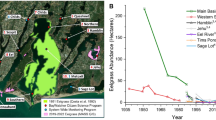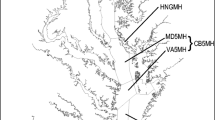Abstract
Nitrogen loads into Lemon Bay, Florida were modeled to have increased ca. 59% between pre-development (i.e., 1850) estimates (5.3 kg TN ha−1 yr−1. and estimates for the year 1995 (8.4 kg TN ha−1 yr−1). By the year 2010, nitrogen loads are predicted to increase an additional 45% or 58%, depending upon progress being made toward replacing older septic tank systems with centralized sewerage (nitrogen loads of 12.2 and 13.3 kg TN ha−1 yr−1, respectively). Using 1995 estimates, nonpoint sources (stormwater runoff) are throught to be responsible for ca. 76% of the annual nitrogen load, followed by septic tank systems (14%), rainfall (10%), and an insignificant load from baseflow. Based on an empirically-derived nitrogen load:chlorophylla relationship developed for a portion of nearby Tampa Bay, a 45% increase in nitrogen loads into Lemon Bay could result in a 29% increase in annual average chlorophylla concentrations. Using the estimate of a 29% increase in future chlorophylla concentrations, an empirically-derived optical model for Lemon Bay suggests that light attenuation coefficients in the bay would increase ca. 9%, and the average depth limit ofThalassia testudinum in Lemon Bay would decrease by ca. 24%.
Similar content being viewed by others
Literature Cited
Alexander, R. B., R. A. Smith, G. E. Schwarz, S. D. Preston, J. W. Brakebill, R. Srinivasan, andP. A. Pacheco. 2001. Atmospheric nitrogen flux from the watersheds of major estuaries of the United States: An application of the SPARROW watershed model, p. 119–170.In R. A. Valigura, R. B. Alexander, M. S. Castro, T. P. Meyers, H. W. Paerl, P. E. Stacey, and R. E. Turner (eds.), Nitrogen Loading in Coastal Water Bodies: An Atmospheric Perspective. American Geophysical Union, Washington, D.C.
Anita, N., P. Harrison, andL. Oliveira. 1991. The role of dissolved organic nitrogen in phytoplankton nutrition, cell biology and ecology.Phycologia 30:81–89.
Avery, W. 1997. Distribution and abundance of macroalgae and seagrass in Hillsborough Bay, Florida, from 1986 to 1995, p. 151–166.In S. Treat (ed.), Proceedings, Tampa Bay Area Scientific Information Symposium 3. Tampa Bay Regional Planning Council, St. Petersburg, Florida.
Burwell, D., M. Vincent, M. Luther, andB. Galperin. 2000. Modeling residence times: Eulerian versus Lagrangian, p. 995–1009.In M. L. Spaulding and H. L. Butler (eds.), Estuarine and Coastal Modeling. American Society of Civil Engineers, Reston, Virginia.
Charlotte Harbor National Estuary Program (CHNEP). 1997. Synthesis of Existing Information for the Greater Charlotte Harbor Watershed. Charlotte Harbor National Estuary Program, North Fort Myers, Florida.
Dawes, C. J. andD. A. Tomasko. 1988. Depth distribution ofThalassia testudinum in two meadows on the west coast of Florida: A difference in effect of light availability.Publicazioni della Stazione Zooligica de Napoli I: Marine Ecology 9:123–130.
Delwiche, L. D. andD. A. Haith. 1983. Loading functions for predicting nutrient losses from complex watersheds.Water Resources Bulletin 19:951–959.
Dixon, L. K. 1999. Establishing light requirements for the seagrassThalassia testudinum: An example for Tampa Bay, Florida, p. 9–31.In S. A. Bortone (ed.), Seagrasses: Monitoring, Ecology, Physiology, and Management. CRC Press, Boca Raton, Florida.
Dixon, L. K. andG. J. Kirkpatrick. 1995. Light Attenuation with Respect to Seagrasses in Sarasota Bay, Florida. Sarasota Bay National Estuary Program, Sarasota, Florida.
Dixon, L. K. andG. J. Kirkpatrick. 1999a. Biological Effects of Atmospheric Deposition on Algal Assemblages. Sarasota Bay National Estuary Program, Sarasota, Florida.
Dixon, L. K. andG. J. Kirkpatrick. 1999b. Causes of Light Attenuation with Respect to Seagrasses in Upper and Lower Charlotte Harbor. Surface Water Improvement and Management Program. Southwest Florida Water Management District, Tampa, Florida.
Estevez, E. D. 1992. Tidal wetlands, p. 6.1–6.20.In P. Roat, C. Ciccolella, H. Smith, and D. Tomasko (eds.), Sarasota Bay Framework for Action. Sarasota Bay National Estuary Program, Sarasota, Florida.
Florida Department of Environmental Protection. 1994. Southwest Florida District Water Quality 1994 305 (b) Technical Appendix. Florida Department of Environmental Protection, Tallahassee, Florida.
Florida Department of Health and Rehabilitative Services. 1994. The Fate of Nutrients and Pesticides in Southwest Florida Soils. Florida Department of Health and Rehabilitative Services, Tallahassee, Florida.
Florida Department of Natural Resources (FDNR) 1991. Lemon Bay Aquatic Preserve Management Plan. Bureau of Submerged Lands and Preserves, Florida Department of Natural Resources, Tallahassee, FL.
Harper, H. H. 1991. Estimation of Loading Rate Parameters for the Tampa Bay Watershed. Southwest Florida Water Management District, Brooksville, Florida.
Heyl, M. G. 1992. Point and non-point source pollutant loading assessment, p. 12.1–12.9.In P. Roat, C. Ciccolella, H. Smith, and D. Tomasko (eds.), Sarasota Bay Framework for Action. Sarasota Bay National Estuary Program, Sarasota, Florida.
Johansson, J. O. R. 1991. Long-term trends in nitrogen loading, water quality and biological indicators in Hillsborough Bay, Florida, p. 157–176.In S. E. Treat and P. A. Clark (eds.), Proceedings, Tampa Bay Areas Scientific Information Symposium 2. Tampa Bay Regional Planning Council, St. Petersburg, Florida.
Johansson, J. O. R. andH. S. Greening. 1999. Seagrass restoration in Tampa Bay: A resource-based approach to estuarine management, p. 279–293.In S. A. Bortone (ed.), Seagrasses: Monitoring, Ecology, Physiology, and Management. CRC Press, Boca Raton, Florida.
Johansson, J. andT. Ries. 1997. Seagrass in Tampa Bay: Historic trends and future expectations, p. 139–150.In S. Treat (ed.), Proceedings, Tampa Bay Area Scientific Information Symposium 3. Tampa Bay Regional Planning Council, St. Petersburg, Florida.
Kurz, R. C., D. A. Tomasko, D. Burdick, T. F. Ries, K. Patterson, andR. Finck. 1999. Recent trends in seagrass distributions in Southwest Florida coastal waters, p. 157–166.In S. A. Bortone (ed.), Seagrasses: Monitoring, Ecology, Physiology, and Management. CRC Press, Boca Raton, Florida.
Lapointe, B. E., J. D. O’Connell, andG. S. Garrett. 1990. Effects of on-site sewage disposal systems on nutrient relations of groundwaters and nearshore surface waters of the Florida Keys.Biogeochemistry 10:289–307.
Lorenzen, C. J. 1972. Extinction of light in the ocean by phytoplankton.Journal de Conseil International pour l’Exploration de la Mer 34:262–267.
McPherson, B. F. andR. L. Miller 1987. The vertical attenuation of light in Charlotte Harbor, a shallow subtropical estuary, south-western Florida.Estuarine, Coastal and Shelf Science 25:721–737.
McPherson, B. F. andR. L. Miller. 1993. Causes of light attenuation in estuarine waters of Southwestern Florida, p. 227–234.In L. J. Morris and D. A. Tomasko (eds.), Proceedings and Conclusions of Workshops on Submerged Aquatic Vegetation Initiative and Photosynthetically Active Radiation. Special Publication SJ93-SP13. St. Johns River Water Management District, Palatka, Florida.
Montgomery, R. T., B. F. McPherson, and E. E. Emmons. 1991. Effects of Nitrogen and Phosphorus Additions on Phytoplankton Productivity and Chlorophylla in a Subtropical Estuary, Charlotte Harbor, Florida. U.S. Geological Survey, Water Resources Investigations Report 91-4077. Tampa, Florida.
Nixon, S. W., J. W. Ammerman, L. P. Atkinson, V. M. Berounsky, G. Billen, W. G. Boicourt, W. R. Boynton, T. M. Church, D. M. DiToro, R. Elmgren, J. H. Garber, A. E. Giblin, R. A. Jahnke, N. J. P. Owens, M. E. Pilson, andS. P. Seitzinger. 1996. The fate of nitrogen and phosphorus at the land-sea margin of the North Atlantic Ocean.Biogeochemistry 15:141–180.
Peierls, B. L. andH. W. Paerl. 1997. The bioavailability of atmospheric organic nitrogen deposition to coastal phytoplankton.Limnology and Oceanography 42:1819–1823.
Ryther, J. andW. Dunstan. 1971. Nitrogen, phosphorus, and eutrophication in the coastal marine environment.Science 171:1008–1012.
Seitzinger, S. andJ. Sanders. 1997. Contribution of dissolved organic nitrogen from rivers to estuarine eutrophication.Marine Ecology Progress Series 159:1–12.
Sheng, Y. P. andS. Peene. 1992. Circulation and its effect on water quality, p. 5.1–5.18.In P. Roat, C. Ciccolella, H. Smith, and D. Tomasko (eds.), Sarasota Bay Framework for Action. Sarasota Bay National Estuary Program, Sarasota, Florida.
Southwest Florida Water Management District. 1999. Southern Coastal Watershed Comprehensive Management Plan. Southwest Florida Water Management District, Brooksville, Florida.
Squires, A. P., H. Zarbock, andS. Janicki. 1998. Loadings of nitrogen, total phosphorus and total suspended solids to Charlotte Harbor, p. 187–200.In S. F. Treat (ed.), Proceedings of the Charlotte Harbor Public Conference and Technical Symposium; 1997 March 15–16; Punta Gorda, Florida. Charlotte harbor National Estuary Program Technical Report No. 98-02. West Palm Beach (Fla.); South Florida Water Management District, Florida.
Stacey, P. S., H. S. Greening, J. N. Kremer, D. Peterson, andD. A. Tomasko. 2001. Contributions of atmospheric nitrogen deposition to U.S. estuaries, p. 187–226.In R. A. Valigura, R. B. Alexander, M. S. Castro, T. P. Meyers, H. W. Paerl, P. E. Stacey, and R. E. Turner (eds.), Nitrogen Loading in Coastal Water Bodies: An Atmospheric Perspective. American Geophysical Union, Washington, D.C.
Stanley, D. 2001. An annotated summary of nitrogen loading to US estuaries, p. 227–252.In R. A. Valigura, R. B. Alexander, M. S. Castro, T. P. Meyers, H. W. Paerl, P. E. Stacey, and R. E. Turner (eds.), Nitrogen Loading in Coastal Water Bodies: An Atmospheric Perspective. American Geophysical Union, Washington, D.C.
Tomasko, D. A. andB. E. Lapointe. 1991. Productivity and biomass ofThalassia testudinum as related to water column nutrient availability and epiphyte levels: Field observations and experimental studies.Marine Ecology Progress Series 75:9–17.
Tomasko, D. A. andM. O. Hall. 1999. Productivity and biomass of the seagrassThalassia testudinum along a gradient of freshwater influence in Charlotte Harbor, Florida.Estuaries 22:592–602.
Tomasko, D. A., C. J. Dawes, andM. O. Hall. 1996. The effects of anthropogenic nutrient enrichment on turtle grass (Thalassia testudinum) in Sarasota Bay, Florida.Estuaries 19:448–456.
Turner, R. E., D. Stanley, D. Brock, J. Pennock andN. N. Rabalais. 2001. A comparison of independent N-loading estimates for U.S. estuaries, p. 107–118.In R. A. Valigura, R. B. Alexander, M. S. Castro, T. P. Meyers, H. W. Paerl, P. E. Stacey, and R. E. Turner (eds.), Nitrogen Loading in Coastal Water Bodies: An Atmospheric Perspective. American Geophysical Union, Washington, D.C.
Walker, W. G., J. Bouma, D. R. Kenney andP. G. Olcott. 1973. Nitrogen transformations during subsurface disposal of septic tank effluent in sands: II. Ground water quality.Journal of Environmental Quality 2:521–525.
Source of Unpublished Materials
Englewood Water District. Personal Communication. 201 Selma Avenue, Englewood, Florida 34223.
Author information
Authors and Affiliations
Corresponding author
Rights and permissions
About this article
Cite this article
Tomasko, D.A., Bristol, D.L. & Ott, J.A. Assessment of present and future nitrogen loads, water quality, and seagrass (Thalassia testudinum) depth distribution in Lemon Bay, Florida. Estuaries 24, 926–938 (2001). https://doi.org/10.2307/1353183
Received:
Accepted:
Issue Date:
DOI: https://doi.org/10.2307/1353183




